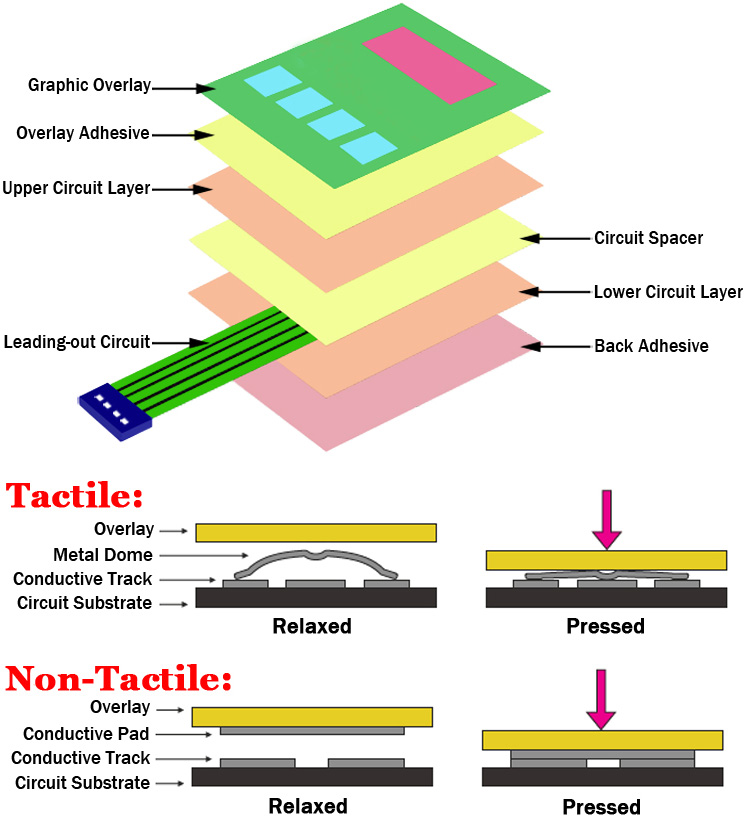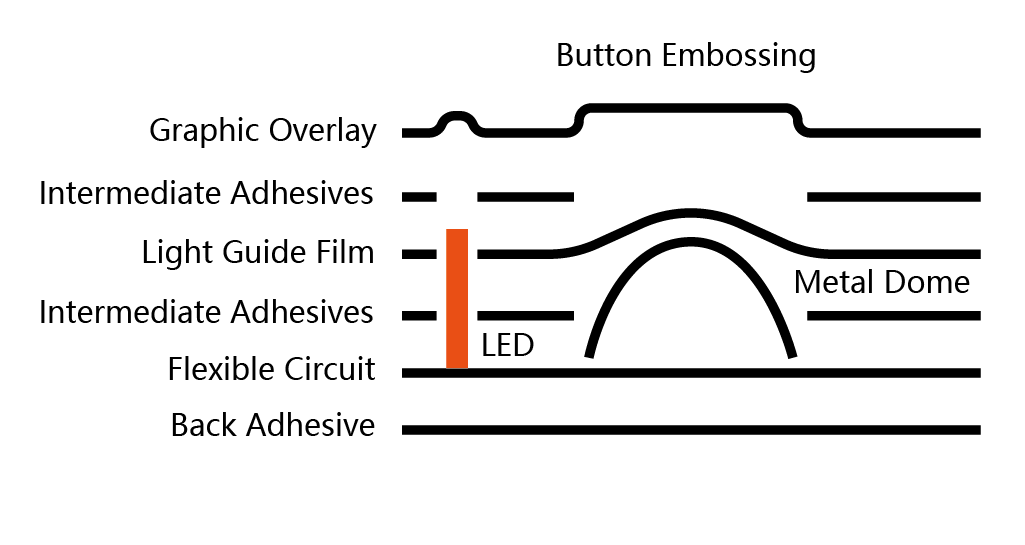Comprehending the Significance of Membrane Change in Modern Electronic Devices
Membrane switches are essential elements in contemporary electronic tools. They supply a blend of functionality and design that improves individual interaction. Their resilient and lightweight nature makes them appropriate for different applications. As industries advance, the demand for personalization and progressed attributes expands. Comprehending exactly how membrane switches over contribute to advancement exposes their importance in shaping the future of electronics. What exists in advance for this innovation?
The Fundamentals of Membrane Layer Switch Over Modern Technology
Although commonly ignored, membrane layer button innovation plays a crucial function in the modern electronic devices landscape - membrane switch. These tools, made up of several layers, function as customer interfaces for numerous digital products, varying from family devices to clinical tools. A normal membrane layer switch is composed of a graphic overlay, a spacer layer, and a circuit layer, which are thoroughly constructed to create a practical interface.When stress is applied to the overlay, the circuit layer is finished, enabling signals to be transmitted to the device. This technology is understood for its versatility, making it possible for customization in form, layout, and performance to fulfill particular user demands. Additionally, membrane layer buttons are thin and light-weight, making them suitable for applications where space is a costs. Their sturdiness and resistance to environmental elements further improve their allure, guaranteeing they can endure harsh conditions while preserving performance. In general, membrane button technology is essential to creating reliable and easy to use electronic devices

Key Advantages of Membrane Layer Changes
Membrane switches offer several vital advantages that make them a favored choice in numerous digital applications. Their layout enables a small type factor, allowing makers to produce sleek and lightweight devices. Additionally, membrane layer switches are immune to dust, dampness, and chemicals, which boosts their durability and longevity in requiring environments. The tactile comments supplied by these buttons can improve user experience, making them intuitive and easy to operate.Furthermore, membrane layer switches can be tailored with varied graphics and shades, permitting unique branding opportunities. The manufacturing process is typically cost-effective, especially for high-volume manufacturing, as it minimizes assembly time and streamlines layout. Ultimately, membrane switches over require marginal upkeep, adding to lower total operational prices. These benefits emphasize their growing popularity in modern-day electronic devices, where integrity and straightforward interfaces are vital.

Applications Across Different Industries
The flexibility of membrane layer changes enables their prevalent adoption throughout various markets. In the medical area, they are commonly utilized in diagnostic tools and patient surveillance systems, providing a sturdy interface resistant to pollutants. The automotive industry utilizes membrane layer buttons for control panel controls, improving individual experience with smooth designs that hold up against rough conditions. In customer electronics, they work as control panels for tools such as microwaves and coffee makers, giving an easy to use interface that is easy to clean. The aerospace sector utilizes membrane buttons in cockpit controls, where reliability and area efficiency are paramount. Additionally, the commercial sector leverages these buttons in equipment and control systems to guarantee robust procedure sought after environments. This wide variety of applications underscores the adaptability of membrane buttons, making them indispensable elements in improving capability and individual communication across varied technological landscapes.
Personalization and Layout Versatility

Future Patterns in Membrane Layer Change Advancement
Arising trends in membrane layer button advancement suggest a growing emphasis on enhanced capability and assimilation with smart innovations. As customer need for more advanced digital tools rises, makers are concentrating on producing membrane layer switches that not only offer basic operational roles yet also include functions like touch level of sensitivity, backlighting, and haptic feedback.Furthermore, developments in products are expected to enhance durability and ecological resistance, making membrane switches suitable for diverse applications in markets such as medical care, vehicle, and consumer electronic devices. The assimilation of capacitive touch modern technology is most likely to end up being extra prevalent, permitting sleeker designs and improved individual interfaces. membrane switch.Additionally, the rise of the Internet of Points (IoT) is motivating the advancement of membrane layer changes that can communicate wirelessly with various other gadgets, improving interconnectivity. Overall, the future of membrane switch modern technology shows up encouraging, driven by development and the quest of user-friendly options
Often Asked Questions
Exactly How Do Membrane Layer Changes Contrast to Standard Mechanical Buttons?
Membrane layer switches, being much more space-efficient and supplying a sleek style, comparison with typical mechanical switches that provide tactile feedback. The previous commonly include personalized graphics, while the latter usually assure durability and integrity in different applications.
What Materials Are Frequently Made Use Of in Membrane Switch Production?
Membrane layer buttons are usually created making use of materials such as polyester, polycarbonate, and printed conductive inks. These products offer responsiveness, flexibility, and durability, making them ideal for various applications in digital tools and individual interfaces.
Can Membrane Layer Switches Over Be Fixed or Reused?
Membrane switches can typically be repaired, especially if small problems occur, such as adhesive failure or surface area damages. Total reuse is generally restricted due to wear and possible deterioration of materials over time.
How Do Ecological Elements Affect Membrane Change Performance?
Ecological variables, such as temperature, moisture, and exposure to chemicals, considerably affect membrane look at this website switch efficiency. Extreme conditions can bring about degradation, affecting responsiveness and longevity, inevitably endangering the performance of the tool in different applications.
What Is the Regular Life Expectancy of a Membrane Layer Change?
The regular life-span of a membrane layer switch normally varies from 1 to 5 million actuations, depending upon aspects such as usage frequency, environmental conditions, and the products utilized in production, influencing sturdiness and performance long life. A typical membrane layer switch consists of a visuals overlay, a spacer layer, and a circuit layer, which are diligently constructed to create a useful interface - membrane switch.When stress is applied to the overlay, the circuit layer is completed, allowing signals to be transferred to the gadget. The responsive responses given by these buttons can boost customer experience, making them intuitive and simple to operate.Furthermore, membrane layer buttons can be tailored with diverse graphics and colors, permitting for special branding opportunities. As consumer need for more innovative electronic devices rises, suppliers are focusing on creating membrane layer switches that not just offer fundamental functional functions but additionally integrate attributes like touch sensitivity, backlighting, and haptic feedback.Furthermore, advancements in materials are expected to enhance longevity and ecological resistance, making membrane layer switches over suitable for diverse applications in markets such as healthcare, automobile, and consumer electronics. The combination of capacitive touch innovation is most likely to come to be a lot more prevalent, permitting for sleeker styles and improved user interfaces.Additionally, the increase of the Net of Points (IoT) is motivating the development of membrane layer switches that can connect wirelessly with various other gadgets, boosting interconnectivity. Membrane layer buttons, being much click here for more info more space-efficient and supplying a sleek design, contrast with traditional mechanical switches that offer responsive feedback